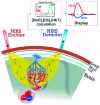Functional Near-Infrared Spectrometry as a Useful Diagnostic Tool for Understanding the Visual System: A Review
- PMID: 38202288
- PMCID: PMC10779649
- DOI: 10.3390/jcm13010282
Functional Near-Infrared Spectrometry as a Useful Diagnostic Tool for Understanding the Visual System: A Review
Abstract
This comprehensive review explores the role of Functional Near-Infrared Spectroscopy (fNIRS) in advancing our understanding of the visual system. Beginning with an introduction to fNIRS, we delve into its historical development, highlighting how this technology has evolved over time. The core of the review critically examines the advantages and disadvantages of fNIRS, offering a balanced view of its capabilities and limitations in research and clinical settings. We extend our discussion to the diverse applications of fNIRS beyond its traditional use, emphasizing its versatility across various fields. In the context of the visual system, this review provides an in-depth analysis of how fNIRS contributes to our understanding of eye function, including eye diseases. We discuss the intricacies of the visual cortex, how it responds to visual stimuli and the implications of these findings in both health and disease. A unique aspect of this review is the exploration of the intersection between fNIRS, virtual reality (VR), augmented reality (AR) and artificial intelligence (AI). We discuss how these cutting-edge technologies are synergizing with fNIRS to open new frontiers in visual system research. The review concludes with a forward-looking perspective, envisioning the future of fNIRS in a rapidly evolving technological landscape and its potential to revolutionize our approach to studying and understanding the visual system.
Keywords: artificial intelligence; augmented reality; brain–computer interfaces; eye; fNIRS; neuroimaging; optical imaging; virtual reality; visual system; visual systems.
Conflict of interest statement
The authors declare no conflict of interest.
Figures





Similar articles
-
Functional near-infrared spectroscopy for the assessment and treatment of patients with disorders of consciousness.Front Neurol. 2025 Feb 3;16:1524806. doi: 10.3389/fneur.2025.1524806. eCollection 2025. Front Neurol. 2025. PMID: 39963381 Free PMC article. Review.
-
A semi-immersive virtual reality incremental swing balance task activates prefrontal cortex: a functional near-infrared spectroscopy study.Neuroimage. 2014 Jan 15;85 Pt 1:451-60. doi: 10.1016/j.neuroimage.2013.05.031. Epub 2013 May 17. Neuroimage. 2014. PMID: 23684867
-
Augmented and virtual reality in spine surgery, current applications and future potentials.Spine J. 2021 Oct;21(10):1617-1625. doi: 10.1016/j.spinee.2021.03.018. Epub 2021 Mar 25. Spine J. 2021. PMID: 33774210 Review.
-
[Neurofeedback technology based on functional near infrared spectroscopy imaging and its applications].Sheng Wu Yi Xue Gong Cheng Xue Za Zhi. 2022 Oct 25;39(5):1041-1049. doi: 10.7507/1001-5515.202204031. Sheng Wu Yi Xue Gong Cheng Xue Za Zhi. 2022. PMID: 36310494 Free PMC article. Chinese.
-
Pain classification using functional near infrared spectroscopy and assessment of virtual reality effects in cancer pain management.Sci Rep. 2025 Mar 15;15(1):8954. doi: 10.1038/s41598-025-93678-y. Sci Rep. 2025. PMID: 40089593 Free PMC article.
Cited by
-
The neurosociological paradigm of the metaverse.Front Psychol. 2025 Jan 7;15:1371876. doi: 10.3389/fpsyg.2024.1371876. eCollection 2024. Front Psychol. 2025. PMID: 39839940 Free PMC article.
-
A dual-branch deep learning model based on fNIRS for assessing 3D visual fatigue.Front Neurosci. 2025 Jun 5;19:1589152. doi: 10.3389/fnins.2025.1589152. eCollection 2025. Front Neurosci. 2025. PMID: 40538859 Free PMC article.
References
-
- Armstrong R.A., Cubbidge R.C. 1—The Eye and Vision: An Overview. In: Preedy V.R., Watson R.R., editors. Handbook of Nutrition, Diet, and the Eye. 2nd ed. Academic Press; Cambridge, MA, USA: 2019. pp. 3–14.
Publication types
Grants and funding
LinkOut - more resources
Full Text Sources
Research Materials

